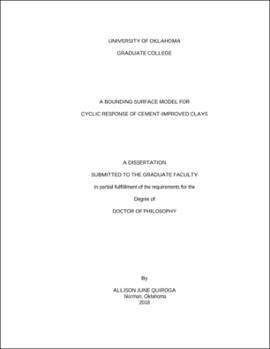| dc.contributor.advisor | Muraleetharan, Kanthasamy | |
| dc.contributor.author | Quiroga, Allison | |
| dc.date.accessioned | 2018-05-09T16:39:07Z | |
| dc.date.available | 2018-05-09T16:39:07Z | |
| dc.date.issued | 2018-05-11 | |
| dc.identifier.uri | https://hdl.handle.net/11244/299821 | |
| dc.description.abstract | The use of chemical stabilization of soft soils to achieve increased strength and decreased compressibility for subgrade and site improvement applications is a well-documented and accepted practice in geotechnical engineering. As use of cement mixing continues to grow in popularity and new applications are proposed, it is important for researchers and designers to have robust and reliable tools for the analysis and design of geotechnical systems utilizing this technology. The need for such tools becomes all the more important when the behavior of such systems has to be analyzed during seismic events. Computational modeling techniques (e.g., finite element or finite difference analysis programs) can be very useful in predicting the behavior of a proposed geotechnical system or structure under different loading conditions before its construction. However, the overall predictive capabilities of such tools are reliant on the algorithms which calculate the stress-strain responses of the individual elements of the model; i.e., the constitutive models.
This research details a bounding surface elastoplastic constitutive model which accounts for the effects of cementation through soil sensitivity and size and aspect ratio of the bounding surface. Destructuring of stabilized soil structure is tracked as a function of volumetric and deviatoric plastic strain accumulation. In order to predict plastic strain accumulation due to unloading and reloading/load-reversal events, the bounding surface concept is extended to incorporate a relocating projection center. Model predictions are compared with consolidation and conventional drained and undrained triaxial compression test results to demonstrate the predictive capability of the model for monotonic loading. A forecast of an undrained, stress-controlled, two-way cyclic shear triaxial test is shown to demonstrate the model’s ability to capture stress-strain phenomena associated with structure degradation due cyclic loading. The proposed model is able to adequately capture the general stress-strain behavior of normally consolidated and lightly overconsolidated soils in post-yield, under drained and undrained compression loading. Suggestions are made to improve the model predictions for soils in pre-yield and soils undergoing large strains. These suggestions include better methods for characterizing the initial sensitivity and its evolution and introducing a non-associative flow rule. | en_US |
| dc.language | en_US | en_US |
| dc.subject | soil mechanics | en_US |
| dc.subject | constitutive model | en_US |
| dc.subject | cement-mixed clay | en_US |
| dc.subject | cyclic | en_US |
| dc.subject | Engineering, Civil. | en_US |
| dc.title | A bounding surface model for cyclic response of cement-improved clays | en_US |
| dc.contributor.committeeMember | Cerato, Amy | |
| dc.contributor.committeeMember | Miller, Gerald | |
| dc.contributor.committeeMember | Wang, Naiyu | |
| dc.contributor.committeeMember | Kaliakin, Victor | |
| dc.contributor.committeeMember | Attar, Peter | |
| dc.date.manuscript | 2018 | |
| dc.thesis.degree | Ph.D. | en_US |
| ou.group | College of Engineering::School of Civil Engineering and Environmental Science | en_US |
| shareok.orcid | 0000-0001-6939-0754 | en_US |
| shareok.nativefileaccess | restricted | en_US |
